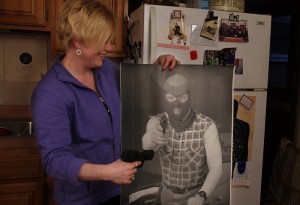Seeking Safety in Steel: The Women of Cathryne Czubek’s Documentary, ‘A Girl & A Gun’
The documentary follows the lives of 10 women: a Massachusetts tai chi instructor, a 19-year-old Arizona champion skeet shooter, a San Francisco Ted columnist, a New Jersey activist mother, a New York City nurse, an Alabama mother who sees “guns as no different than a food processor,” an Oklahoma survivor of a home invasion, an army war vet, an incarcerated woman in the Louisiana Correctional Facility, and a Tennessee woman with a long family history of game hunting. If you’re beginning to think this film is more about women than about guns, you’re on the right track.
Take Robin Natanel, a 40-something tai chi instructor, whom we meet roaming the aisles of a Bass Pro Shop in search of a .20 gauge shotgun. The musical score, written by Andrew Hollander, harkens to a ballerina’s entrance — the tinkling, pitter-patter of the Nutcracker Suite, perhaps. A well-dressed Natanel teeters around the store in stiletto heels scoping out not just guns but camouflaged clothing and accessories designed especially for women: frilly vests and hats with netting that would make even the Queen Mum envious (more on this later). It is a jolting, conflicting scene that challenges one’s preconceived notions about women and guns and sets the stage for the rest of the movie.
A voiceover queries, “When we see a woman with a gun, we don’t know what to think. Who is she really?” It is the leitmotif running through Czubek’s film: the age-old dichotomy of the femme fatale versus the vestal virgin. When the camera zooms in on Natanel’s flashy earrings and rolls down the long-barreled shotgun too heavy for her to hold, we question why this woman is driven to purchase a gun. “This is kind of like shoe shopping for me,” Natanel says laughing, and turns her attention to the handgun display. As Natanel’s story progresses, we learn not only the reason she chooses to arm herself but also how heavy the burden is to be the owner of a firearm. As Stephanie Alexander, the New Jersey gun activist whose daughter was seriously injured in a shooting, notes, “When you take care of a gun, it’s like taking care of a child.”
Family plays a critical role in many of these women’s lives — be it tradition, an opportunity to spend time with male family members or a means of protecting one’s family in the absence of a male figure. There is more than one woman whose family has felt the effects of a gunshot wound or fatality. Their losses, gracefully portrayed, are so boundless, so palpable that you may wonder why they would ever want to be near a gun again, but as Sarah McKinley, a single mother, notes, “I want to feel safe in my own home.”
At 19, Emily Blount is the youngest subject in the film. With long, silky hair pulled into a ponytail, she doesn’t look a day older than 15. Blount’s reason for owning a gun is different than many of Czubek’s subjects: she’s a professional skeet shooter. “It was a way to spend time with my dad,” she explains. Her father and coach wipes proud tears from his eyes while standing with her at a shooting range in Arizona’s arid landscape. When she returned from the world championships, an $11,000 rifle awaited her. She strokes it with slender, well-manicured fingers and explains, “It’s pretty. And I can’t stop touching it. It’s my best friend… It’s my first boyfriend.” Someone on the camera crew chuckles, and Blount looks up and smiles with the timidity of a teenager going to her first dance: “Really,” she replies.
At face value their stories — from all four corners of the United States — are distinct, and yet they blend into a harmonic symphony that portrays female gun ownership as a means of empowerment and self-protection. As Violet Blue, a TED Columnist, explains, “You move through the world as a target, when you are female — period. We do see and hear things differently, because we’re constantly concerned about our well-being and our safety; those women who aren’t, come from a very privileged status.” Blue, who keeps a Lady Smith .45 loaded next to her bed, finds that owning a gun is equal to “owning my freedom. It’s owning my power. It’s owning my womanhood.”
This sense of woman’s empowerment — the belief in controlling one’s own destiny and safety — was fostered by one of America’s greatest cultural icons: Annie Oakley, the star sharpshooter of Buffalo Bill Cody’s Wild West show from 1885-1902. Known as “Little Sure Shot,” a moniker given to her by her adopted Sioux father, Sitting Bull, Oakley was a strong proponent of a woman’s ability to defend herself and hearth; she trained over 15,000 girls and women in firearm safety and shooting during her lifetime, and even offered President Wilson “a regiment of women for home protection, every one of whom can and will shoot if necessary” in 1917. The president, evidently not interested, dismissed her offer.
Oakley was a celebrity — having performed across the United States and Europe, entertaining royalty and common folk alike with her amazing shooting precision. She even shot the ash off German Kaiser Wilhelm’s cigarette. Less than a decade after her death, filmmaker George Stevens elevated her stature in history with his film, Annie Oakley (1935). In casting the alluring Barbara Stanwyck as Oakley — whom film critic Pauline Kael described as bringing “a physical charge to the role” — Stevens created one of the most indelible icons of cinematography: the gun-toting woman.
(Article continued on next page)

